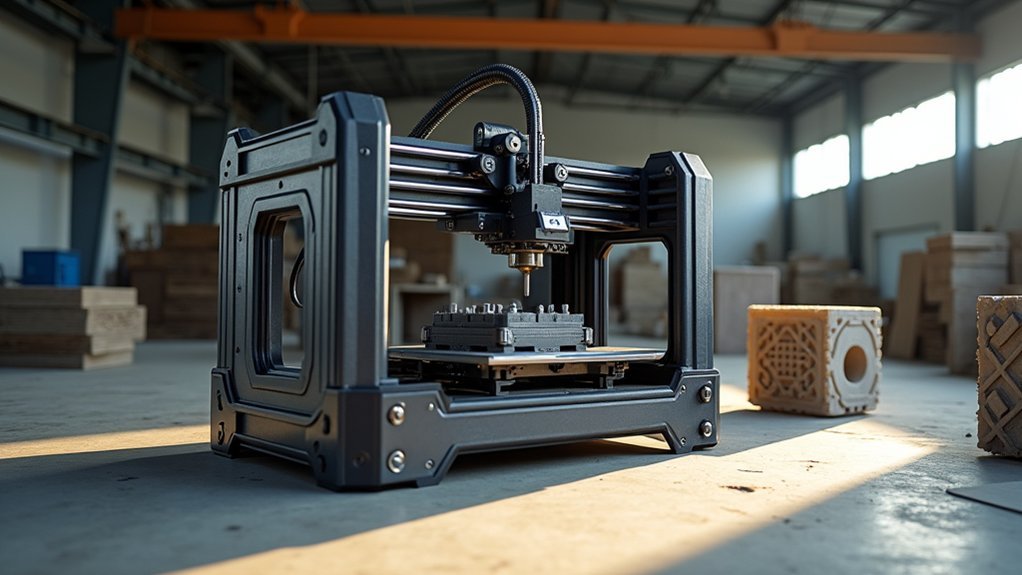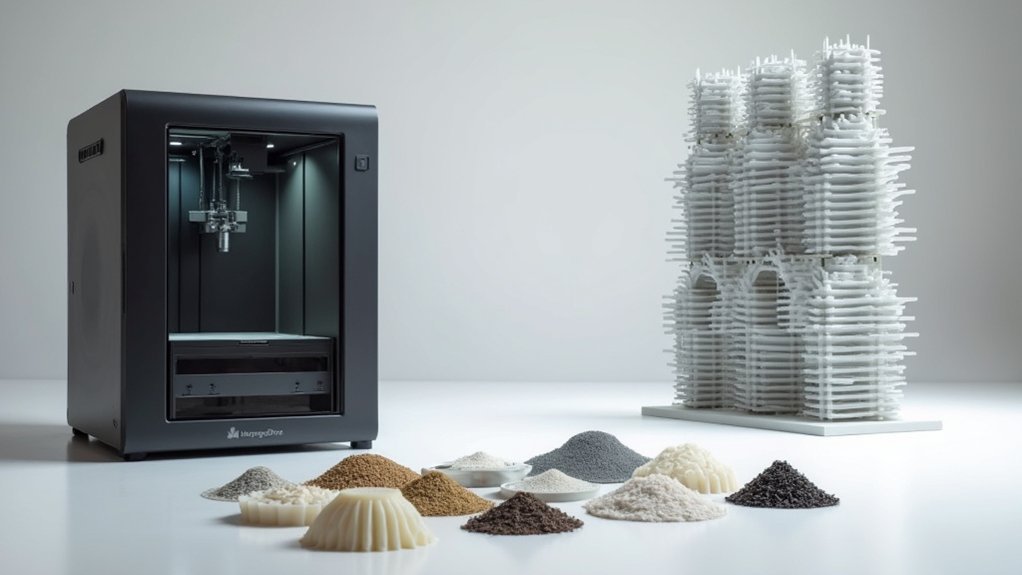You’ll need industrial 3D printers with minimum 500x500x500mm build volumes, high-temperature capabilities up to 150°C, and engineering-grade material compatibility for prefab construction success. Top models feature dual extruders, CoreXY motion systems, and robust steel frames that handle ABS, nylon, and concrete composites. Initial investments range $50,000-$100,000 but deliver ROI within 1-3 years through 60% efficiency gains and reduced labor costs. You’ll discover which specific models excel in construction environments and how they transform your manufacturing workflow.
What Makes a 3D Printer Suitable for Prefab Construction Projects

When you’re selecting a 3D printer for prefab construction projects, the build volume stands as the most critical factor—you’ll need a minimum of 500x500x500mm to produce large components in single pieces that maintain structural integrity and slash assembly time.
Your machine must handle high-temperature materials like ABS, Polycarbonate, and Nylon, which deliver the durability and weather resistance construction demands.
You’ll want advanced features including CoreXY or Cartesian motion systems for enhanced speed and precision, ensuring your parts fit together seamlessly.
Dual extruder capabilities expand your design possibilities by enabling multi-material prints. A reliable machine equipped with auto-bed leveling and filament sensors prevents costly print failures, keeping your prefab projects on schedule and within budget.
Key Technical Specifications for Construction-Grade Large Format Printers
Beyond the fundamental requirements for prefab construction, several technical specifications separate professional construction-grade large format printers from standard desktop models.
You’ll need a minimum build volume of 500x500x500mm to fabricate substantial components in single prints, ensuring modular building applications remain feasible. Your large format 3D printer should feature robust steel or aluminum frames that maintain stability during 100+ hour print runs common in construction projects.
High-temperature capabilities are essential, with heated beds reaching 150°C to accommodate engineering-grade materials like ABS, nylon, and polycarbonate.
Professional-grade construction printers demand heated beds reaching 150°C to process engineering materials like ABS, nylon, and polycarbonate effectively.
Dual extruder systems enable simultaneous multi-material printing, enhancing component complexity and functionality. You’ll also want advanced firmware options like Klipper or Marlin that optimize print speed and reliability for fast-paced construction environments.
Top Industrial 3D Printers for Building Component Manufacturing

When you’re selecting industrial 3D printers for building component manufacturing, you’ll need machines that can handle high-volume production with build chambers exceeding 1000x1000x1000mm to accommodate prefabricated construction elements.
Your chosen printer must demonstrate compatibility with structural materials like concrete, thermoplastics, and composites while maintaining the precision engineering standards required for load-bearing components.
You’ll also want to prioritize systems that can produce parts up to 10 times faster than traditional methods while ensuring consistent quality across large-scale manufacturing runs.
High-Volume Production Capabilities
As prefab construction demands accelerate, you’ll find that high-volume production capabilities have become the cornerstone of successful large format 3D printing operations. These large-scale 3D printer systems deliver high accuracy while maintaining big build volumes, enabling you to manufacture complete building components in single print runs.
| Capability | Build Volume | Production Benefit |
|---|---|---|
| Wall Panels | >2000mm | Reduced Assembly Time |
| Structural Components | Oversized Elements | Lower Manufacturing Costs |
| Complex Geometries | Multi-Material Support | Enhanced Design Freedom |
| Batch Production | Continuous Operation | Maximized Throughput |
You’ll achieve significant cost reductions by eliminating assembly steps and minimizing material waste. With dual extruders and high-temperature capabilities, you can process reinforced plastics and composites that meet stringent building standards while maintaining structural integrity throughout high-volume production cycles.
Structural Material Compatibility
Structural material compatibility determines whether your large format 3D printer can handle the demanding requirements of prefab construction projects.
You’ll need a machine that works with engineering-grade materials like concrete, thermoplastics, ABS, Nylon, and Polycarbonate to create high-strength building components.
Advanced models reach bed temperatures up to 150°C, enabling you to use high-temp structural materials that enhance component integrity and print quality.
Your large 3D printer should offer dual extruder capabilities for multi-material printing, allowing you to incorporate reinforcement features directly into components.
This compatibility allows you to print large parts in single pieces, reducing assembly requirements and material waste.
The ability to handle diverse structural materials guarantees your printer can adapt to various construction applications while maintaining the durability standards essential for prefab building components.
Precision Engineering Requirements
Since building components demand exactness that rivals traditional manufacturing, precision engineering becomes the cornerstone of successful large format 3D printing for construction applications.
You’ll need printers that maintain dimensional accuracy across large build volumes like 12.5 x 12 x 20 inches, ensuring structural integrity throughout entire components. Large-format 3D printers excel when they combine high speeds with consistent layer adhesion, preventing warping that compromises building standards.
Your precision engineering requirements include temperature control up to 150°C for engineering-grade materials like ABS, Polycarbonate, and Nylon.
Dual extruder systems must maintain perfect alignment to produce complex geometries without defects. The AXIOM 20 exemplifies these capabilities, delivering repeatable accuracy that meets construction tolerances.
When you’re manufacturing prefab components, every micron matters for proper assembly and long-term performance.
Material Compatibility and Structural Requirements for Construction Applications

When you’re selecting a large format 3D printer for prefab construction, you’ll need to guarantee it can handle engineering-grade materials like ABS, polycarbonate, and nylon that provide the structural integrity your building components demand.
Your printer must accommodate these construction-grade materials while maintaining the precision necessary for load-bearing applications where safety and durability can’t be compromised.
You’ll also want high-temperature capabilities reaching 150°C bed temperatures to properly process these advanced materials that’ll withstand real-world construction environments.
Construction Grade Materials
Material compatibility forms the backbone of successful prefab construction projects, where your choice of engineering-grade filaments directly impacts structural integrity and long-term performance. You’ll need printers capable of reaching 150°C bed temperatures to process ABS, Polycarbonate, and Nylon effectively. These materials provide the strength and durability essential for structural components.
| Material | Temperature Requirements | Construction Benefits |
|---|---|---|
| ABS | 220-250°C / 80-100°C bed | Impact resistance, weatherability |
| Polycarbonate | 270-310°C / 120-150°C bed | High strength, transparency options |
| Nylon | 240-280°C / 70-100°C bed | Chemical resistance, flexibility |
Your large build area enables printing sizable components in one piece, while dual extruder systems let you combine different materials for enhanced functionality and structural reinforcements within single prints.
Load Bearing Requirements
Although your material selection provides the foundation, understanding load-bearing requirements secures your printed components can withstand the structural demands of real-world construction applications.
Your big 3D printer must accommodate engineering-grade materials like ABS, Polycarbonate, and Nylon to meet these demanding specifications. You’ll need high-temperature capabilities for printing 100% pure materials that deliver superior load-bearing performance.
Structural requirements dictate minimum wall thickness and robust design features, which advanced printers achieve through customizable settings and dual-extruder capabilities.
You should prioritize machines offering high precision with minimum 500x500x500mm build volumes. This guarantees your components meet exact specifications for building frameworks and supports.
When your printer handles these load-bearing requirements effectively, you’re creating structures capable of withstanding demanding construction environments.
Cost Analysis and ROI Considerations for Construction Companies
Before committing to large format 3D printing technology, you’ll need to carefully evaluate the financial implications and potential returns for your construction business. While initial investments range from $50,000 to $100,000, the enhanced production speed and cost savings typically deliver substantial returns.
Key financial benefits include:
- Reduced material waste through precise additive manufacturing processes
- Enhanced production speed boosting work efficiency by up to 60%
- Lower labor costs from single-piece component production eliminating assembly requirements
- Faster project completion timelines increasing overall profitability
- Revenue growth through rapid prototyping and client customization capabilities
Most construction companies achieve return on investment within 1-3 years due to decreased operational costs and expanded project capabilities, making large format 3D printing a financially viable technology upgrade.
Installation Space Requirements and Workflow Integration
When planning your facility layout for large format 3D printing integration, you’ll need to designate at least 100 square feet of floor space to accommodate the printer’s operational footprint and essential peripherals.
Your installation space requirements should include clearance around all sides for maintenance access and monitoring capabilities. Position the build platform strategically near material storage areas and assembly zones to minimize handling time and enhance production efficiency.
Strategic positioning of your build platform near storage and assembly areas maximizes workflow efficiency while ensuring proper maintenance access.
You’ll need dedicated electrical connections and proper ventilation systems to handle high-temperature materials effectively.
Don’t overlook workflow integration software that streamlines your design-to-print processes, reducing lead times considerably. This setup enables real-time project adjustments and maintains ideal printing conditions throughout your prefab construction operations, ensuring seamless production flow.
Maintenance Protocols and Long-Term Performance for Construction Environments
Since construction environments expose large format 3D printers to demanding conditions, you’ll need extensive maintenance protocols that exceed standard desktop printer requirements.
These protocols directly impact print accuracy and performance reliability throughout your printer’s operational life.
Your maintenance strategy should include:
- Frame stability checks – Verify alignment weekly to prevent print inaccuracies during extended operations
- Moving parts lubrication – Clean and lubricate rails and linear bearings every few weeks to minimize wear
- Consumable replacement – Monitor nozzles and print bed surfaces regularly to prevent clogs and maintain adhesion
- Humidity control – Install workspace moisture management to protect materials like nylon and PLA
- Activity logging – Track maintenance, failures, and material usage to identify operational patterns requiring adjustments
Frequently Asked Questions
What Is the Best Type of 3D Printing for Construction?
You’ll find extrusion-based technologies like Fused Deposition Modeling most effective for construction 3D printing. They efficiently process concrete and construction materials, reducing build times by up to 70% while maintaining structural integrity.
What Is the 45 Degree Rule for 3D Printing?
You’ll need support structures when your 3D print overhangs exceed 45 degrees from vertical. This rule prevents sagging and collapse during printing, especially with FDM printers where gravity affects layer deposition.
How Much Does a Large Format 3D Printer Cost?
You’ll spend between $50,000 to $100,000 for most large format 3D printers suitable for prefab construction. Entry-level models start around $30,000, while industrial-grade options can exceed $150,000 depending on capabilities.
What Is the Best Size 3D Printer Build?
You’ll want at least 500x500x500mm for substantial components, but you should consider 2000mm+ models if you’re printing large structural elements like walls and beams for maximum efficiency.





Leave a Reply